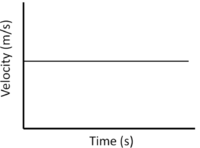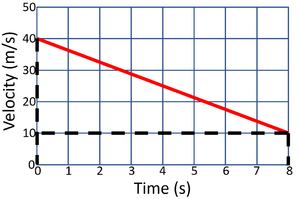Difference between revisions of "Velocity-Time Graph"
(→Calculating Acceleration) |
(→Calculating Distance Travelled) |
||
| Line 68: | Line 68: | ||
====Calculating Distance Travelled==== | ====Calculating Distance Travelled==== | ||
| − | : The [[distance]] travelled can be calculated from a '''velocity-time graph''' by breaking the [[graph]] into simple shapes and finding the [[area]] of those shapes. This may use the equations <math> | + | : The [[distance]] travelled can be calculated from a '''velocity-time graph''' by breaking the [[graph]] into simple shapes and finding the [[area]] of those shapes. This may use the equations <math>area = base \times height</math> for rectangular shapes and <math>area = \frac{base \times height}{2}</math> for triangular shapes. |
{| class="wikitable" | {| class="wikitable" | ||
| + | | style="height:20px; width:300px; text-align:left;" |'''Calculate the [[distance]] travelled by the [[object]] in this journey.''' | ||
| + | | style="height:20px; width:300px; text-align:left;" |'''Calculate the [[distance]] travelled by the [[object]] in this journey.''' | ||
|- | |- | ||
|[[File:vtGraphCalculateArea1.png|center|300px]] | |[[File:vtGraphCalculateArea1.png|center|300px]] | ||
|[[File:vtGraphCalculateArea2.png|center|300px]] | |[[File:vtGraphCalculateArea2.png|center|300px]] | ||
|- | |- | ||
| − | | style="height:20px; width: | + | | style="height:20px; width:200px; text-align:left;" |'''1. State the known quantities''' |
| + | base = 8s | ||
| + | |||
| + | height = 30m/s | ||
| + | | style="height:20px; width:200px; text-align:left;" |'''1. State the known quantities''' | ||
| + | base = 8s | ||
| + | |||
| + | height = 40m/s | ||
| + | |- | ||
| + | | style="height:20px; width:200px; text-align:left;" |'''2. [[Substitute (Maths)|Substitute]] the numbers into the [[equation]] and [[Solve (Maths)|solve]].''' | ||
| + | |||
| + | <math>area = b \times h</math> | ||
| + | |||
| + | <math>area = 8 \times 30</math> | ||
| + | |||
| + | <math>area = distance = 250m</math> | ||
| + | | style="height:20px; width:200px; text-align:left;" |'''2. [[Substitute (Maths)|Substitute]] the numbers into the [[equation]] and [[Solve (Maths)|solve]].''' | ||
| + | |||
| + | <math>area = \frac{b \times h}{2}</math> | ||
| + | |||
| + | <math>area = \frac{8 \times 40}{2}</math> | ||
| − | + | <math>area = \frac{320}{2}</math> | |
| + | <math>area = distance = 160m</math> | ||
|} | |} | ||
Revision as of 12:52, 14 February 2019
Contents
Key Stage 4
Meaning
A velocity-time graph is a graph that shows how the velocity of an object changes with time.
About Velocity Time Graphs
- Velocity-time graphs give information about the journey taken by an object.
- On a velocity-time graph the velocity is plotted on the y-axis and the time is plotted on the x-axis.
- A velocity-time graph can be used to calculate the acceleration of an object or the distance travelled by the object.
- The gradient of a velocity-time graph is the same as the acceleration.
- The area under the curve on a velocity-time graph is the distance travelled by an object.
| Constant Velocity | Accelerating | Decelerating |
| A gradient of zero shows the object is travelling at a constant velocity. | Acceleration is shown by a positive gradient. | Deceleration is shown by a negative gradient. |
Example Calculations
Calculating Acceleration
- The acceleration can be calculated from a velocity-time graph by reading the graph and using the equation \(a=\frac{v-u}{t}\).
| Calculate the acceleration of the object in this journey. | Calculate the acceleration of the object in this journey. |
| State the known variables.
v = 40m/s u = 20m/s t = 8s |
State the known variables.
v = 10m/s u = 40m/s t = 8s |
| 2. Substitute the numbers into the equation and solve.
\(a = \frac{v-u}{t}\) \(a = \frac{40-20}{8}\) \(a = \frac{20}{8}\) \(a = 2.5m/s/s\) |
2. Substitute the numbers into the equation and solve.
\(a = \frac{v-u}{t}\) \(a = \frac{10-40}{8}\) \(a = \frac{-30}{8}\) \(a = -3.75m/s/s\) |
Calculating Distance Travelled
- The distance travelled can be calculated from a velocity-time graph by breaking the graph into simple shapes and finding the area of those shapes. This may use the equations \(area = base \times height\) for rectangular shapes and \(area = \frac{base \times height}{2}\) for triangular shapes.
| Calculate the distance travelled by the object in this journey. | Calculate the distance travelled by the object in this journey. |
| 1. State the known quantities
base = 8s height = 30m/s |
1. State the known quantities
base = 8s height = 40m/s |
| 2. Substitute the numbers into the equation and solve.
\(area = b \times h\) \(area = 8 \times 30\) \(area = distance = 250m\) |
2. Substitute the numbers into the equation and solve.
\(area = \frac{b \times h}{2}\) \(area = \frac{8 \times 40}{2}\) \(area = \frac{320}{2}\) \(area = distance = 160m\) |






